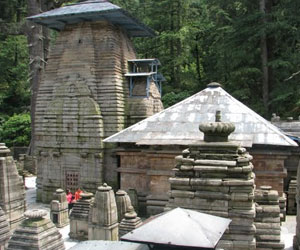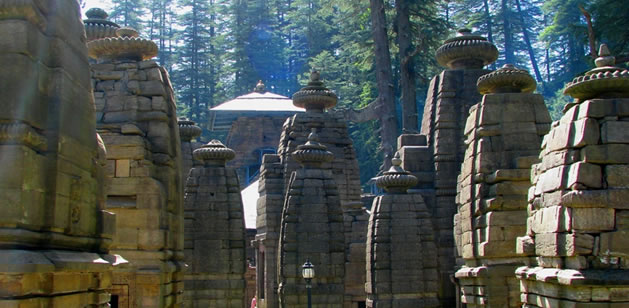
Jageshwar is located at an altitude of 1870 meters. Jageshwar is the 8th Jyotirling among the Twelve and has great religious value.
Jageshwar Shiv temple is one of the oldest shiva temple in India.
Jageshwar is a Hindu pilgrimage town in Almora District, dedicated to Lord Shiva, located 36 km northeast of Almora and around 101 Kms away from Nainital in Kumaon Region of Uttarakhand Uttranchal.
The temple city of Jageshwar comprises a cluster of 124 large and small stone temples, dating 9th to 13th century AD, with many preserved by the Archaeological Survey of India (ASI), which include Dandeshwar Temple, Chandi-ka-Temple, Jageshwar Temple, Kuber Temple, Mritunjaya Temple, Nanda Devi or Nau Durga, Nava-grah Temple, a Pyramidal shrine, and Surya Temple amongst which the oldest shrine is the ‘Mrityunjaya Temple’ and the biggest shrine is the ‘Dandeshwar Temple’. Once the centre of Lakulish Shaivism, in the Jataganga river valley near a Deodar forest (Cedrus deodara) starting from Artola village on Almora–Pithoragarh highway, where two streams Nandini and Surabhi flow down the hills in the narrow valley and meet near the sacred spot.

The townfolk believe that Jageshwar is the place of Nagesh among the forest of Deodar, 8th among the Dwadasa Jyotirlingas: the twelve resplendent lingas of Lord Shiva established by Lord Vishnu.
The ‘ Jageshwar Monsoon Festival ‘, held between 15 July to 15 August takes place at Jageshwar during the Hindu calendar month of Shravan, and the annual ‘Maha Shivratri Mela’ (Shivratri festival), which takes place during spring has an important place in the calendar of the entire Kumaon region.
History of Jageshwar
The ancient treatise Prasadmandanam describe Jageshwar as an Abode of Lord Shiva.
There is no definite dating of the construction of Jageshwar group of temples but according to the ASI, they belong to the post-Gupta and pre-medieval eras and are estimated to be about 2500 years old and one of the oldest temple in India. These temples range in the period from the 8th century (early Katyuri Dynasty to the 18th century (Chand Dynasty). The temples were renovated during the reign of Katyuri King Shalivahandev. There is an inscription of Malla Kings on the main temple premises indicating their devotion to Jageshwar. The Katyuri Kings also donated villages to the temple priests for it’s maintenance. The Chand Kings of Kumaon were also patrons of the Jageshwar temple.
Jageshwar Dham in the year 1890
It is believed that Adi Shankaracharya visited Jageshwar and renovated and re-established many temples before leaving for Kedarnath. The Samsan ghat of Jageshwar is also the cremation ground of the erstwhile Chand Kings. It is possible that sati, the act of self-immolation, may have been performed here. The temples architecture belong to the Nagara style, characterized by a tall curved spire surmounted by an amalaka (capstone) and a kalasha crown. Most of the temples enshrine a stone lingam, surrounded by stone scultptures of various deities. The pilgrimage to Jageshwar was considered as sacred as the famous chardham yatra.
Before the construction of roads, pilgrims passed through Jageshwar en route to Kailash and Mansarovar. Due to the restrictions on pilgrimage to Kailash Mansarovar in the past, pilgrims were diverted towards Kedarnath; however, this center has re-attained its past glory.
The main temple in the temple complex at ‘Jageshwar Mahadev’ is dedicated to ‘Bal Jageshwar’, or the Child Shiva. There is also a temple dedicated to Vridh Jageshwar, or Old Shiva, situated on the higher slopes. According to tradition, Lord Shiva came to meditate here, and when the women of the village came to know of this, they immediately left their household chores to have his darshan. When the men of the village heard of this, they were infuriated and came to see who is this sadhu who has captivated their woman. Seeing the commotion, Shiva took the form of a child, which is why he is still worshipped in his child form here
Jageshwar Dham is about 91 km. from Soulitude in the Himalayas.

